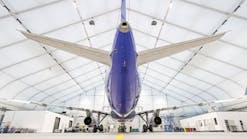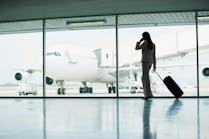Achieving Airport Comfort, Health, Security and Cost-Efficiency Through Digital Transformation
The travel industry has experienced unprecedented setbacks during the COVID-19 pandemic, with US airlines reporting a 65% year-over-year reduction in scheduled service passengers in September. For airports, this means a steep reduction in non-aeronautical revenues usually generated by passenger dining, shopping and parking. While the industry is seeing promising improvements in passenger traffic volumes, especially around the holidays, it is still a long way from a complete return to normal operations. Airports need to implement recovery strategies that will not only enable them to navigate the COVID-19 pandemic but remain prepared for any future crisis situation as well.
It’s estimated that a 1% increase in passenger satisfaction generates approximately 1.5% in non-aeronautical airport revenue growth; as airports shepherd in a new era of air travel, it’s clear that the key to success will be the restoration of passenger trust, safety and overall satisfaction. Airports can make strategic infrastructure updates and leverage digital solutions to provide passengers with a healthier and safer airport environment today with the flexibility to adapt spaces for future emergency situations. Clean air, touchless environments, contact tracing, sophisticated ventilation and sanitization systems and flexible facilities are all critical considerations for working, traveling and gathering in airports.
Cultivating a healthy passenger experience through digital solutions
As consumers return to airports across the country, they will naturally have concerns regarding the safety of their experience. Will there be social distancing? How are they screening passengers for symptoms? How clean is the air? How clean are the facilities? These apprehensions will likely linger long after the pandemic ends. To assuage these concerns and instill consumer confidence that lasts, it is up to airport leaders to provide a comprehensively safe and healthy passenger and staff experience from the moment they enter the building to the final boarding call. Delivering a smarter, healthier, more connected airport environment requires a holistic approach that looks beyond the physical infrastructure to bring together operational and informational technology to harness actionable data, finding opportunities for safer, healthier and better occupant experiences, as well as cost-saving operational efficiencies.
By applying data-driven technologies and processes, airports can leverage data collected from inside and outside the facilities to glean actionable, operational insights that empower them to optimize the health and security of both passengers and staff and provide a customized response to any emergency situation. Key technology implementations include:
- Elevated skin temperature screening: Instead of manually scanning every individual entering the airport, elevated skin temperature screening solutions integrate with existing video surveillance systems for automated processes. Leveraging artificial intelligence (AI) capabilities, the solution automatically scans large volumes of moving individuals for anomalous temperatures and can instantly notify security when detected. These thermal cameras can even be installed within airport parking garages to begin fever detection at passengers’ first touchpoint.
- Advanced AI-enabled monitoring solutions: To ensure compliance with safety guidelines, social distance monitoring and mask detection solutions allow airports to remotely monitor passengers for noncompliance in real time. Security managers can be instantly notified of any concerning behavior, allowing for a swift and professional response.
- Frictionless Environments: Frictionless technologies reduce the potential for touch contamination between individuals and contribute to an overall healthier environment for building occupants. Replacing boarding passes with biometric devices creates touchless boarding processes, protecting passengers and staff. Frictionless action control can be implemented within sensitive airport areas, leveraging facial recognition technology to maximize security while reducing touch contamination on keypads.
- Air filtration and disinfectant systems: Upgrading HVAC units and their filters to maximize the circulation of clean outdoor air improves buildings’ overall indoor air quality (IAQ) and clean air delivery rate (CADR). To deactivate viruses and other airborne contaminants, ultraviolet-C (UV-C) lighting and bipolar ionization (BPI) technologies can be installed, whether as updates to HVAC units or as in-zone troffers.
- Real-time monitoring and diagnostics: These can measure the health of the airport facilities and its sanitization status, including key cross-contamination variables such as room pressurization, air change rates, humidity and temperature.
To streamline operations and truly provide comprehensive infection control, these technologies can be integrated with building automation systems (BAS) to allow airport operators to pre-program emergency building sequences. For instance, an airport could quickly and seamlessly activate the building’s “pandemic mode” to automate clean air processes like cross-contamination shutdown or thermal flush, rather than manually adjusting each building system. By investing in intelligent technologies now, airport managers can be better prepared for the unexpected later.
Boosting non-aeronautical revenue and finding cost savings
Passengers are still exercising caution when considering air travel, but studies show consumers are slowly but surely returning to airports. In fact, the Transportation Security Administration reported more than one million people were screened in a single day in October, the first time it has passed this milestone since March. With airlines collectively losing $5 billion each month, maximizing revenue output from the passengers who are flying is therefore critical to recovery. Digital solutions are foundational for capturing passenger and location data to help airports direct passenger flow, expedite security processes and ensure easier connections. The result is more time for passengers to shop, dine and explore, and more efficiently managed airport resources.
With margins tight, generating cost savings is just as crucial as generating revenue. Climate change, government emission targets and unpredictable, rising energy costs mean that reducing building energy use and carbon emissions is becoming a priority for airport operators with aging infrastructure. Technology assessments can provide a holistic review of building, business and airport systems within the airport campus, generating a baseline knowledge about existing systems within the facility and how they are integrated. With this information, airport operators can identify the digital solutions and systems investment necessary to help monitor and manage equipment, environments and enterprises to increase energy efficiency and sustainability.
For example, investing in remote asset monitoring allows airport facility managers to predict building systems’ breakdowns before they happen, avoiding costly emergency repairs. With fewer passengers flying, many airports are maintaining departure and arrival gates that remain empty. Integrating the flight schedule with airports’ BAS, HVAC and lighting allow them to reduce the costs associated with maintaining unused areas. Optimizing utility management through integration is a key component to regaining airline services – and by extension, their passengers – as well. Additional implementations like solar photovoltaic (PV) grids and water efficiency solutions contribute to long-term energy and cost savings, all of which can impact the bottom line for airports and airlines alike.
A lasting shift in the transportation industry’s mindset
In the months and years following the September 11th tragedy, airports around the globe made major investments in security to renew public trust. As we continue to operate during the COVID-19 pandemic, airport leaders must put the same level of investment and commitment in their public health and safety measures to restore trust once again.
With 2020 coming to a close, now is the time for airport leaders to ask themselves how they can ensure a safer, healthier, more connected travel experience in an airport with the flexibility and resiliency to support future travel requirements. By investing in the digital transformation of the airport, operators can find operational efficiencies that positively impact the bottom line, and create healthier, safer and more satisfying passenger experiences through the pandemic and beyond.
Ramsey’s 30 year background has involved all aspects of the global aviation industry, he has worked for several international airlines as well as various related suppliers. During the last 12 years his focus has been mainly within North American airports, providing leading edge passenger processing solutions and support systems. With his operational experience, Ramsey brings a unique perspective to Johnson Controls and the industry.






